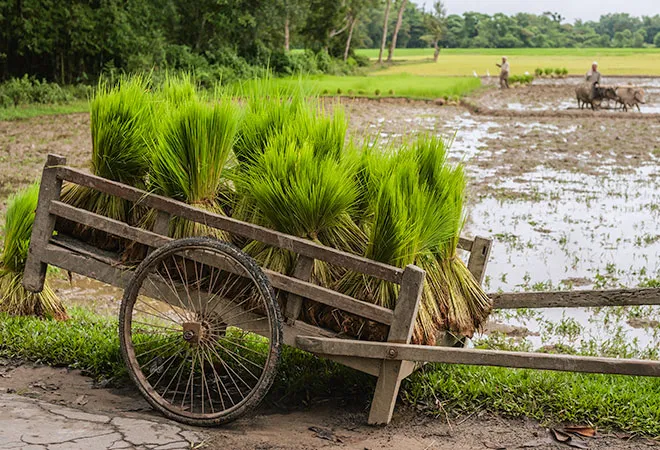Assam is not new to the trail of destruction caused by disasters. In what has now become an annual phenomena, every year intense rainfall during the monsoon season cause the Brahmaputra River to overflow, causing massive devastation to downstream states. While India’s investment in forecast technologies, large-scale disaster evacuation strategies and effective relief operations have been able to save lives, the amount of people severely affected due to loss and damage of critical infrastructure have been significant.
According to Assam State Disaster Management Authority (ASDMA), the deluge has destroyed 2,323 villages, 110,000 hectares of crop area, disrupted transport and communication networks, healthcare systems, affecting over 2.49 million people. The recently released first scientific ‘Assessment of Climate Change over the Indian Region’ has warned that a projected rise in average temperature is likely to exacerbate such disasters with greater intensity and frequency.
It is, therefore, urgent for India to devise a comprehensive policy framework for climate- resilient infrastructure that could significantly reduce the socio-economic vulnerabilities by anticipating, preparing for, and adapting to changing climate conditions. As extreme events are becoming the ‘new normal’ in an increasingly climate-constrained world, India’s critical infrastructure must be built to withstand, respond to, and recover rapidly from the disruptions they cause.
As extreme events are becoming the ‘new normal’ in an increasingly climate-constrained world, India’s critical infrastructure must be built to withstand, respond to, and recover rapidly from the disruptions they cause
Over the recent years, recurrent disasters have already extracted a devastating cost. Cyclone Amphan caused an estimated infrastructure damage of $13 billion in West Bengal, 1.6 times the overall economic loss caused by super cyclone Fani in 2019. Kerala’s total recovery need due to the damage caused by 2018 floods was more than Rs 310 billion. Mumbai suffered a loss of Rs 1.8 billion due to monsoon floods between 2005 and 2015. In the last 20 years, India has incurred a loss of $80 billion to climate disasters.
The vulnerability of India’s critical infrastructure to climate extremes would not only undermine development gains but also have severe implications for its ecosystems, economic productivity, energy and food security, and public health.
India’s development policies do not lay any explicit focus on effective integration of climate resilience concerns in infrastructure building. The national government’s flagship schemes for infrastructure development such as the Atal Mission on Rejuvenation and Urban Transformation (AMRUT), the Smart Cities Mission, or Pradhan Mantri Aawas Yojna (PMAY) put greater emphasis on better service delivery. While the National Action Plan for Climate Change (NAPCC) mandates local governments to include climate adaptation and mitigation strategies into their development projects, studies reveal that their incorporation has remained cursory, mainly to ensure smooth flow of project funds from the government.
An aggressive strategy to integrate climate resilience in all aspects of infrastructure development from planning, design, construction, operation and maintenance, while addressing the financial, technical and capacity gaps is an immediate imperative. Investing in climate resilient infrastructure at an unprecedented scale would yield the triple dividend of saving lives and livelihoods, minimising economic loss and ensuring efficient allocation of resources for development.
Investing in climate resilient infrastructure at an unprecedented scale would yield the triple dividend of saving lives and livelihoods, minimising economic loss and ensuring efficient allocation of resources for development
The successful transformation of infrastructure would require an effective implementation process on ground. In India, most of the venerable regions do not adhere to the provisions of The Model Building Bye-laws 2016 that provides for risk classification of buildings and climate-resilient construction. Moreover, majority of states do not maintain an up-to-date record of critical infrastructure such as housing, water systems, transport network, etc. that could inform proper land use planning. In the absence of a strict regulatory, monitoring and compliance mechanism, there would be continued unplanned, hazardous development, exposing India’s vulnerable region to future climate risks.
Designing new climate resilient infrastructure and adaptation projects would require strong technical capacity for climate modelling and projection. India should collectively mobilise its existing institutional climate capabilities for predicting disasters. This would include the Indian Space Research Organisation (ISRO), the National Remote Sensing Agency (NRSA), and the India Meteorological Department (IMD) to create comprehensive map that could guide the design, plan and delivery on resilient infrastructure building. Each of the disaster events faced are also opportunities to carry out stimulations and analysis of their impact on major infrastructure.
COVID-19 has highlighted the deep vulnerabilities within critical infrastructure systems — ill-equipped and inadequate public health facilities, supply chain, poor housing and lack of energy access have impacted the eventual scale of the pandemic. In post-COVID-19 restructuring of economy, India has a huge opportunity to rethink design, planning and management of its infrastructure systems. As infrastructure is a key pillar towards the achievement of an Aatmanirbhar Bharat (self-reliant India), it is imperative that new infrastructure development in India is made resilient to withstand future shocks, including those brought by climate change.
This commentary originally appeared in Moneycontrol.
The views expressed above belong to the author(s). ORF research and analyses now available on Telegram! Click here to access our curated content — blogs, longforms and interviews.




 PREV
PREV


